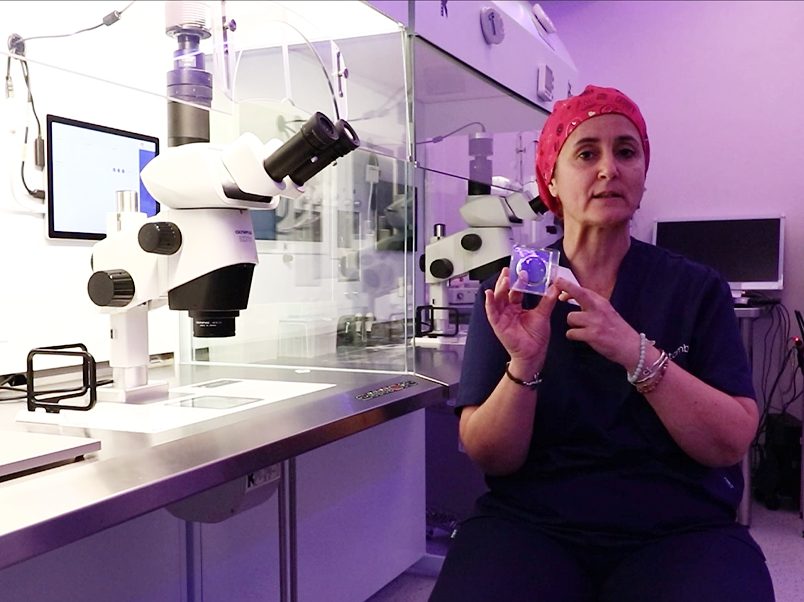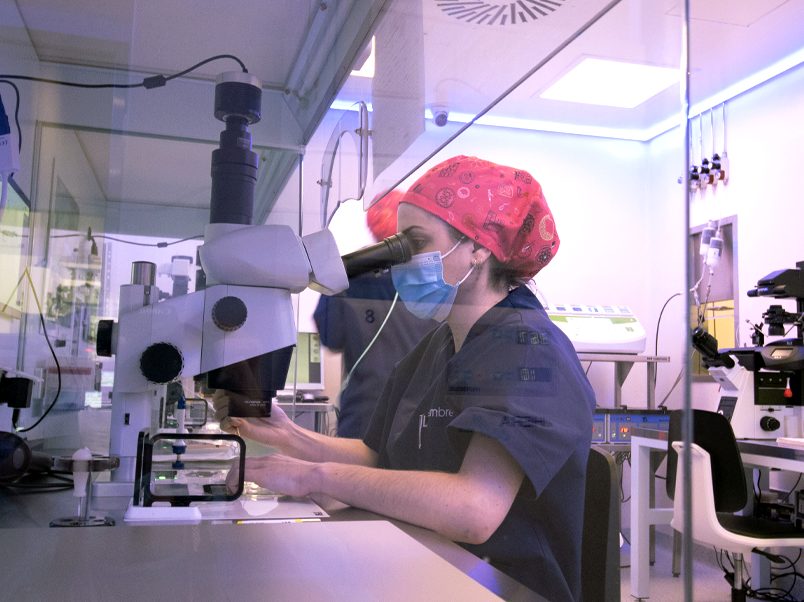blog tambre
Traceability and safety control in the IVF laboratory

Table of contents
The in vitro fertilization (IVF) laboratory is the heart of Tambre and everything that takes place within it is undertaken with extreme care. In particular, security and traceability systems, as well as control of the IVF laboratory environment, are fundamental in this care. This offers reassurance to our patients that their genetic material is being identified safely and accurately and ensures the eggs, sperm and embryos are in optimal condition. This of course, increases the success rates of assisted reproduction treatments.
At Tambre we were pioneers in the implementation of the Witness System in 2008, a surveillance and security method which is used in the IVF and Andrology laboratories, that allows for the traceability of patients’ biological material (eggs, sperm and embryos) to be followed. This type of traceability system is not mandatory in Spain, which is why not all clinics offer it or similar control systems. At Tambre however, our patients are our priority, and this why we use systems like this to offer them security and peace of mind.
Traceability and safety protocol in the Tambre IVF laboratory
The implementation of an objective and safe control system in the laboratory allows us to avoid any possible confusion that may occur during the manipulation or movement of our patients’ biological material.
The Witness System uses radio frequency identification. All the work surfaces of the laboratory and the clinic rooms involved in the process (IVF laboratory, andrology laboratory, operating rooms) have radiofrequency readers that allow us to identify the patient at all times, as well as the tubes or plates in which we cultivate gametes, embryos, etc.
The protocol we follow at Tambre is:
1- Before ovarian puncture, or artificial insemination, we give our patients an identification card which contains their name and that of any partner, their date of birth and other basic information that could be used for verification purposes throughout the process.
The patient then inserts their card into an encoder as they enter the operating theatre prior to the ovarian puncture. This ensures that the laboratory receives the patient’s identification details. At the same time, a nurse will confirm the patient’s first and last name prior to delivering the first tube of biological samples to the laboratory. In this way identification is subject to a double check by the electronic system and the clinic staff.
2- After the puncture, and at each embryologists’ work station there is an encoder that reads by radio frequency a sticker on the plate in which we deposit the oocytes. In this way it automatically identifies the patient. In addition to the identification sticker, the patient’s name is also inscribed on the plate. This happens for every plate that enters the work station. The system alerts staff, both audibly and visually if there is any biological material nearby that doesn’t belong to the patient.
Different plates are used throughout the process. Each time a new one is used, it is coded with the patient’s name.
Throughout the entire process, the IVF laboratory’s security system records the staff member who performs each technique, how long it takes, and who handles each plate, … in short, it records all the traceability of the embryos and biological material.
3- Seminal sample. The process is the same in those cases which involve a semen sample, with the sample being identified with the name of the patient and his partner.
4- If there is a donation, the data is also coded and a control is carried out to find out which patient has received the gametes from a specific donor.
5- Vitrification. At the end of the culture, when we have the blastocyst that we are going to freeze, we identify the straw with a barcode into which we enter information about the patient and other details about the number of embryos, number of oocytes, etc. When the time comes to thaw gametes, we remove the straw from the nitrogen tank in which it has been preserved, and we read the barcode to confirm what material is stored there and who it belongs to. This ensures there is no risk of error.
6- Transfer. At the time of transfer, the process is similar. The patient must show their identification card at the entrance to the operating theatre at which time the system confirms their identity. The laboratory plates are also checked for a match and finally the nurse and gynaecologist confirm the patient’s data before carrying out the embryo transfer.
Other control systems in the Tambre laboratory
In addition to the Witness Embryo Traceability System, we, at Tambre carry out other security processes and protocols in the IVF laboratory that are essential for the correct handling and preservation of gametes and embryos:
- Temperature control
To ensure the viability of oocytes, sperm and embryos in the Tambre laboratory we carry out daily temperature and gas controls. In the incubators, which are the most sensitive part of the system, we have a double point of temperature control.
- PH control
The optimal pH of the media is controlled by the CO2 concentration of the incubators. Thus, increases or decreases in this gas can cause our pH to rise or fall. In addition, pH is also influenced by temperature, which is why it is so important to control both temperature and CO2 levels.
- Microbiological and volatile organic compound controls
Every month, microbiological controls are carried out throughout the surgical area, which includes the embryology and cryobiology laboratories and the operating theatre In addition, the control of volatile organic compounds (VOC) from the laboratories is added to ensure that we do not have any toxic element in the environment which would negatively affect the cultivation of our embryos. We must be vigilant to identify any such toxic compounds.
- Positive air flow
Positive air flow prevents the entry of air and particles from other rooms. In this way, air is able to leave the laboratory, but no gas or volatile organic compounds can enter that might harm the embryos.
- Strict cleaning protocols
To guarantee maximum biological safety and eliminate any risk of infection, the entire team working in the laboratory follow strict hygiene protocols, which is why items such as perfumes, makeup, nail varnish, etc are prohibited. In addition, the laboratory material is single-use and all biological waste is disposed of in special containers.
- Controls in the cryogenic bench
In the liquid nitrogen tanks in which the embryos and gametes are cryopreserved, there is a temperature sensor to ensure there are no nitrogen leaks or a loss of temperature, which would endanger all the biological material. At Tambre, these cryogenic banks are connected to an alarm that, in the event of any problem, alerts laboratory staff. If it occurs at night when there is no one in the laboratory, staff are alerted by mobile phone in order that they can return to make a physical check.
- Time-Lapse Incubators
In order to improve embryonic development in the Tambre laboratory we have state-of-the-art time-lapse incubators, which allow us to view the embryos individually, 24 hours a day. This prevents embryologists from having to remove the plates from the incubator to check the status and evolution of the embryos under the microscope.
In this way, we manage to keep the condition of the embryos as stable as possible, avoiding manipulation, exposure to light and temperature changes. In addition, the incubators also have their own alarm systems, which warn of any change in temperature or other problems in order that laboratory staff can address these quickly.
Do you have any doubts?
At Tambre we take care of all the essential aspects of the treatments we perform in the clinic and ensure safety, because what is important for you is also important for us. The application of these systems provides a greater degree of peace of mind and confidence. We are at your disposal if you have questions about traceability and safety in the IVF laboratory or want more information about the treatments we develop in Tambre. Contact us and request your first appointment now at +44 (0) 20 38 688 650.


